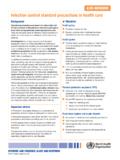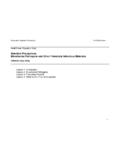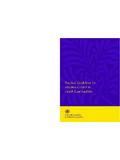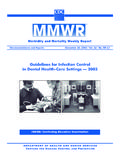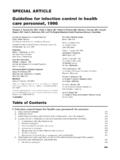Transcription of ANNEX 1 Standard Precautions for Hospital Infection
1 ANNEX 1 Standard Precautions for Hospital InfectionControl13 Standard Precautions aim to reduce the risk of disease transmission in the healthcare setting, even when the source of Infection is not known. StandardPrecautions are designed for use with all patients who present in the health caresetting and apply to: Blood and most body fluids whether or not they contain blood Broken skin Mucous reduce the risk of disease transmission in the health care setting, use thefollowing Standard hands immediately with soap and water before and after examiningpatients and after any contact with blood, body fluids and contaminateditems whether or not gloves were worn.
2 Soaps containing anantimicrobial agent are clean, ordinary thin gloves anytime there is contact with blood, bodyfluids, mucous membrane, and broken skin. Change gloves between tasksor procedures on the same patient. Before going to another patient,remove gloves promptly and wash hands immediately, and then put onnew a mask, protective eyewear and gown during any patient-care activitywhen splashes or sprays of body fluids are likely. Remove the soiled gownas soon as possible and wash needles and other sharp instruments safely.
3 Do not recap sure contaminated equipment is not reused with another patient untilit has been cleaned, disinfected, and sterilized properly. Dispose ofnon-reusable needles, syringes, and other sharp patient-care instruments inpuncture-resistant clean and disinfect frequently touched surfaces including beds,bed rails, patient examination tables and bedside and disinfect soiled linens and launder them safely. Avoid directcontact with items soiled with blood and body from Garner JS, Hospital Infection Control Practices Advisory for IsolationPrecautions In Hospitals,January 1996.
4 Centers for Disease Control and Prevention, Public health Service, USDepartment of health and Human Services, Atlanta, a patient whose blood or body fluids are likely to contaminatesurfaces or other patients in an isolation room or the use of invasive procedures to avoid the potential for injuryand accidental exposure. Use oral rather than injectable medicationswhenever a specific diagnosis is made, find out how the disease is transmitted. Useprecautions according to the transmission risk. If airborne the patient in an isolation room that is not air-conditioned orwhere air is not circulated to the rest of the health facility.
5 Makesure the room has a door that can be a HEPA or other biosafety mask when working with thepatient and in the patient s movement of the patient from the room to other areas. Place asurgical mask on the patient who must be moved. If droplet the patient in an isolation a HEPA or other biosafety mask when working with movement of the patient from the room to other areas. Ifpatient must be moved, place a surgical mask on the patient. If contact the patient in an isolation room and limit gloves during contact with patient and with infectious bodyfluids or contaminated items.
6 Reinforce handwashing throughoutthe health two layers of protective movement of the patient from the isolation room to sharing equipment between patients. Designate equipmentfor each patient, if supplies allow. If sharing equipment isunavoidable, clean and disinfect it before use with the next 1 ANNEX 2 Specific Features of VHFs14 Geographical and epidemiological characteristics of VHFsDiseaseGeographyVector/ReservoirHuma n InfectionCrimean Congo HF Africa Balkans China (Western) Former SovietUnion (Southern) Middle EastTicks.
7 Tick-mammal-tickmaintenance. Tick bites. Squashing ticks. Exposure to aerosols or fomites from slaughtered cattle and sheep (domesticanimals do not show evidence of illness but may become infected whentransported to market or when held in pens for slaughter). Nosocomial epidemics have HF, DengueShock Syndrome(DHF/DSS)All Tropic andsubtropical RegionsAedes Transmission occurswith the frequent geographictransport of viruses by world-wide distribution of the mosquito and the movement of dengueviruses in travellers is increasing the areas that are becoming HF andMarburg HFAfricaUnknown.
8 Virus is spread by close contact with an infected person. Route of Infection of the first case is unknown. Infected non-human primates sometimes provide transmission link to humans. Aerosol transmission is suspected in some monkey FeverWest of themouse. Transmitted by aerosols from rodent to man. Direct contact with infected rodents or their droppings, urine, or saliva. Person-to-person : The reservoir rodent is very common in Africa and the disease is a majorcause of severe febrile illness in West CJ, Zaki SR, Rollin PE.
9 Viral Hemorrhagic Fevers, Chapter 10 in Atlas of Infectious Diseases, vol 8, vol ed Robert Fekety, book ed GL Mandell. Philadelphia:Churchill Livingstone. 1997: and epidemiological characteristics of VHFsDiseaseGeographyVector/ReservoirHuma n InfectionRift Valley FeverSub-Saharan AfricaFloodwater between mosquitoesand domestic animals, particularlysheep and cattle. Mosquito bite. Contact with blood of infected sheep, cattle, or goats. Aerosols generated from infected domestic animal blood. No person-to-person transmission Fever Africa South AmericaAedes Occasional humaninfection occurs when unvaccinatedhumans enter forest.
10 In an urbanoutbreak, virus maintained ininfectedAedes aegyptimosquitoesand humans. Mosquito bite. In epidemics, mosquitoes amplify transmission between humans. Fully developed cases cease to be viremic. Direct person-to-persontransmission is not believed to be a problem although the virus is highlyinfectious (including aerosols) in the clinical features of VHFsDiseaseIncubation PeriodCase FatalityCharacteristic FeaturesCrimean Congo HF3-12 days15% - 30%Most severe bleeding and ecchymoses (a purplish patch caused by bloodcoming from a vessel into the skin) of all the HF andMarburg HF2-21 days25% - 90% Most fatal of all HF.










